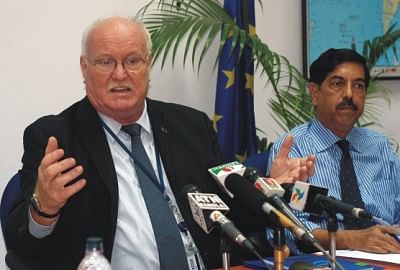Bangladesh top exporter in European market

Stefan Frowein, head of the Delegation of the European Commission to Bangladesh, speaks at a press briefing at the European Union office in Dhaka yesterday. Photo: STAR
Bangladesh was the top export performer in the European Union market in 2009 with 6 percent growth, when all other countries, except for Qatar, suffered an export fall in the common market due to a global financial contraction.
Qatar exported products worth three billion euros to the EU in 2009, predominantly hydrocarbon.
Bangladesh shipped products worth 5.8 billion euros to the EU in 2009, increasing from 5.7 billion euros in 2008, witnessing a 6.3 percent rise. During the time, Bangladesh outperformed its global competitors: China, India and Vietnam.
In 2009, China posted a 13.4 percent export fall in the EU market compared to 2008, while India sustained 13.9 percent and Vietnam 9.5 percent. At the same time, EU's import from the global market shrank 23.4 percent.
Bangladesh's export to the EU was not tainted probably because "Bangladesh exports items that are not sensitive to income variables", said Stefan Frowein, head of the Delegation of the European Commission to Bangladesh, at a press briefing at its office in Dhaka yesterday.
The press meet was organised to give updates on EU-Bangladesh bilateral trade.
EU's exports to Bangladesh slipped 5.5 percent to one billion euros in 2009, compared to a year ago.
The average year-on-year export growth of the country was 9 percent in the last five years.
At the briefing, Zillul Hye Razi, trade adviser of EU trade delegation to Bangladesh, said the use of the generalised system of preferences (GSP) facility increased significantly in the last five years for exports from Bangladesh to EU.
In 2005, some 66 percent of export products used the GSP facility, an instrument that offers tariff rebate to the least developed countries to export to the EU market, while it increased to over 80 percent in 2009.
"Greater utilisation of the GSP means that backward linkage industries are strengthening in the country," Razi said, adding that Bangladesh got benefits worth 493 million euros using the facility in 2009, while India got 456 million euros and Vietnam 153 million euros.
Bangladesh was the fourth largest GSP preferential importer to the EU market in 2008, only after India, Thailand and Brazil.
At the function, participants also voiced concern over the country's dependency on some products and a few export destinations.
Over 80 percent of the country's export earnings come from RMG and more alarmingly, four broad categories of products -- T-shirt, sweater, shirt and trouser -- account for around 85 percent to 90 percent of total RMG exports.
"It is great risk if exports depend on only a few items. You need to diversify both export items and export destinations," said Frowein. He said shipbuilding created hope, as new orders are being placed from EU countries to Bangladesh to build small ships.
He also urged shipbuilders to maintain delivery timelines and quality, to create a stronger image of the sector abroad.
Razi said Bangladesh performed better in the EU market than Vietnam and India as its products are still competitive in the world market.
"The present flow of order placement in the RMG sector is now so strong that in some cases, they are over the capacity of the RMG makers," he added.
Razi also found no major external challenge for the country's export sector in the running year.
Andrew Barnard, First Secretary to EU Delegation in Bangladesh, also spoke.

 For all latest news, follow The Daily Star's Google News channel.
For all latest news, follow The Daily Star's Google News channel. 




Comments